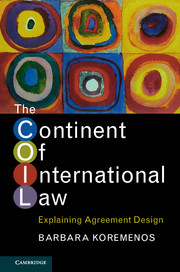Book contents
- Frontmatter
- Dedication
- Contents
- List of figures
- List of tables
- Acknowledgments
- 1 (Re)discovering the continent
- Part I COIL's building blocks: theory and data
- Part II Flexibility provisions in the design of international law
- Part III Centralization, scope, and control provisions in the design of international law
- Appendix 1 List of agreements in COIL sample
- Appendix 2 Coding rules
- Appendix 3 Selection issues in international cooperation data sets
- References
- Index
Part II - Flexibility provisions in the design of international law
Published online by Cambridge University Press: 05 June 2016
- Frontmatter
- Dedication
- Contents
- List of figures
- List of tables
- Acknowledgments
- 1 (Re)discovering the continent
- Part I COIL's building blocks: theory and data
- Part II Flexibility provisions in the design of international law
- Part III Centralization, scope, and control provisions in the design of international law
- Appendix 1 List of agreements in COIL sample
- Appendix 2 Coding rules
- Appendix 3 Selection issues in international cooperation data sets
- References
- Index
Summary
Introduction to Part II
One of the underlying tenets of international relations is that the effects of uncertainty are particularly dramatic in the international context given there is no authority to ensure state survival. Suppose that states cannot anticipate whether a cooperative endeavor will benefit them or whether the benefits, in particular the distribution of benefits, will be stable over time. Cooperation might be precluded if the uncertainty is great and the states involved do not particularly trust each other's long-term intentions. Domestic shocks that affect international cooperative endeavors are also quite common, whether they be economic shocks that affect particularly important interest groups or security-related shocks like internal strife. Can states use institutional design to internalize or contract around the effects of such uncertainty? Contracting around uncertainty may not only make more cooperation possible. Uncertainty is also a major source of reneging in the international realm. It follows that agreements designed to accommodate uncertainty are less likely to be reneged upon than are those not designed that way. Thus institutional design might also affect the robustness of cooperation.
Part II of this book addresses this theme by focusing on the institutional design tool of flexibility as a way of accommodating various forms of Uncertainty about the State of the World as well as Distribution problems. Duration provisions, escape clauses, withdrawal clauses, imprecision, and reservations are examined. In each chapter, the descriptive statistics and empirical analyses challenge some of the conventional wisdom. Chapter 4 on finite duration provisions shows the prevalence of this type of hands tying and explains how it can actually increase the credibility of commitment. Chapter 5 on escape and withdrawal clauses first presents surprising descriptive statistics about the types of agreements that allow escape as well as the vast variation even within issue areas on this dimension; with respect to withdrawal provisions (dismissed by some as examples of those final treaty clauses that are written without much thought), I find them to be strikingly meaningful and systematic in terms of both the length of their notice period and the time stipulated before they can be invoked. Chapter 6 argues that vague language and reservations are deliberate, rational choices, which implies that agreements incorporating such design tools are intended and expected to influence state behavior.
- Type
- Chapter
- Information
- The Continent of International LawExplaining Agreement Design, pp. 99 - 102Publisher: Cambridge University PressPrint publication year: 2016



